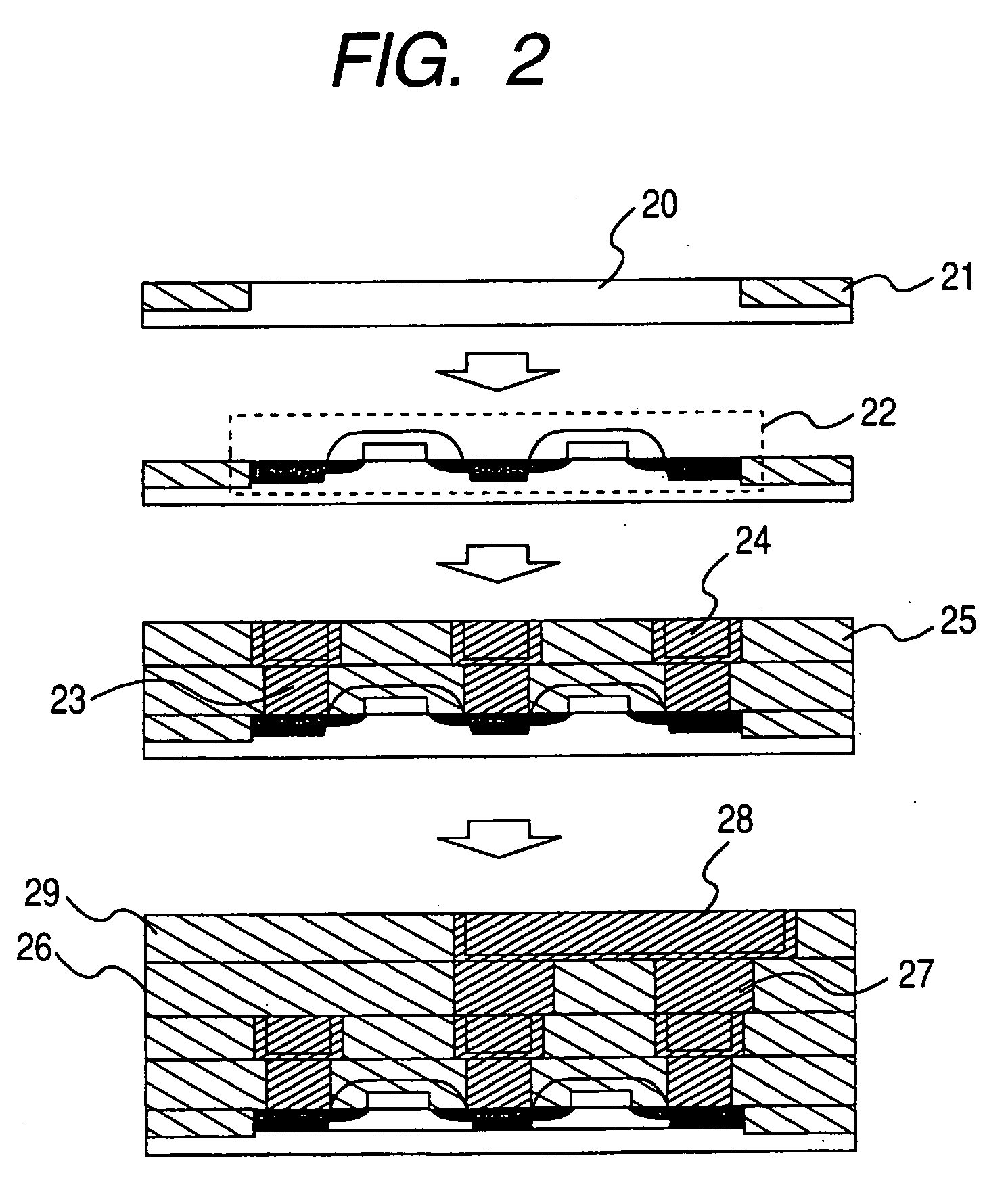Method for producing electronic device
a technology of electronic devices and manufacturing methods, applied in the field of lithography, can solve the problems of inability to obtain desired transistor performance, surplus leakage current generation, edge roughness present in miniaturization, etc., and achieve the effects of low cost, high integration, and high performan
- Summary
- Abstract
- Description
- Claims
- Application Information
AI Technical Summary
Benefits of technology
Problems solved by technology
Method used
Image
Examples
embodiment 1
[0059] As another embodiment of the present invention, an example will be described in which t-butoxycarbonylethyl-β-cyclodextrine (1) is synthesized.
[0060] Under a nitrogen current, sodium hydrate 1.7 g (0.07 mol) was diffused into tetrahydrofuran 30 ml, and a tetrahydrofuran solution 70 ml of β-cyclodextrine 11.3 g (0.010 mol) was dropped. After dropping, it was stirred at room temperature for about 30 minutes, after which bromoacetic acid t-butyle ester 13.7 g (0.07 mol), and tetra-n-butyl ammonium bromide 1.1 g (3.5 mol) were added at once, and refluxing was carried out for 3 hours. Then, a reaction solution obtained was poured into water 40 ml, extraction was done with ethyl acetate, and an organic layer was washed with water three times. The organic layer was dried with sodium sulfate, after which sodium sulfate is filtered, a solvent was removed under reduced pressure from the filtrate for concentration, precipitated again with n-hexane, and then dried to thereby obtain t-bu...
embodiment 2
[0079] As another embodiment of the present invention, an example in which 1-ethoxy ethyl calyx [4] resorcinol arene (IV) was synthesized will be described hereinafter. Resorcinol 10.0 g, aceto aldehyde 4.0 g, and distilled water 60 g were stirred, and undiluted sulfuric acid 10 ml was slowly dropped thereon. After dropping, it was refluxed for 4 hours at 70° C., water of 1 l was added after termination of reaction and stirred for about 10 hours. Thereafter, a solid portion was filtered and re-crystallized with ethanol to obtain calix [4] resorcinol arene 11.5 g.
[0080] Next, calix [4] resorcinol arene 10.9 g (0.020 mol) is dissolved into tetrahydrofuran 100 ml, into which were put ethyl vinyl ether 13.8 g (0.192 mol) and pyridinum-p-toluene sulfonate 0.90 g and closely plugged, and reacted for 10 hours. After reaction, ethyl acetate 200 ml was added, and washed with 150 ml water three times. Thereafter, it was dried with sodium sulfate, sodium sulfate was filtered, filtrate was con...
embodiment 3
[0097] As another embodiment of the present invention, an example will be described in which t-Butoxy carbonyl methyl fullerene is synthesized.
[0098] Under a nitrogen current, sodium hydrate 0.17 g (7.0 mol) was diffused into tetrahydrofuran 10 ml, and commercially available aqueous fullerene C60(OH)n(n=22-26) 1.13 g (1.0 mmol) was additionally diffused to a tetrahydrofuran solution 10 ml. It was stirred at room temperature for about one hour, after which bromoacetic acid t-butyle ester 0.14 g (7.0 mmol), and tetra-n-butyl ammonium bromide 0.011 g (0.035 mmol) were added at once, and heating was carried out for one hour at 60° C. Then, the reaction solution obtained was poured into water 40 ml, and the separation was filtered and washed with water to obtain t-Butoxy carbonyl methyl fullerene 1.05 g (molecular weight 1933).
[0099] The thus obtained t-Butoxy carbonyl methyl fullerene 100 parts by weight, acid generator triphenyl sulfonium nonafrate 5 parts by weight, and phenyl pyriz...
PUM
 Login to View More
Login to View More Abstract
Description
Claims
Application Information
 Login to View More
Login to View More - R&D
- Intellectual Property
- Life Sciences
- Materials
- Tech Scout
- Unparalleled Data Quality
- Higher Quality Content
- 60% Fewer Hallucinations
Browse by: Latest US Patents, China's latest patents, Technical Efficacy Thesaurus, Application Domain, Technology Topic, Popular Technical Reports.
© 2025 PatSnap. All rights reserved.Legal|Privacy policy|Modern Slavery Act Transparency Statement|Sitemap|About US| Contact US: help@patsnap.com



